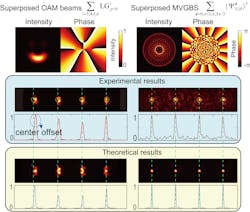New approach promising for free-space optical communication capacity expansion
Building on an existing method for supporting optical data channels, work by a multinational team of researchers could address future issues prompted by the growing demand for higher information bandwidth.
Using different orthogonal spatial modes for different transmission channels, mode-division multiplexing (MDM) of independent optical degrees of freedom (DoF) can expand data capacity. Among all spatial modes, beams carrying orbital angular momentum (OAM)—described by Xing Fu, a professor at Tsinghua University (China), as “the component of angular momentum of a light beam that is dependent on the field spatial distribution, not on the polarization”—could, in theory, accommodate infinite orthogonal modes. But putting that to real-world practice is a different story.
“In practice, the OAM modal set alone cannot reach the capacity limit of a communication channel since the beam diverges rapidly as the OAM order enlarges,” Fu says. Alongside fellow Tsinghua professor Qiang Liu, Fu leads new research (published in Light: Science & Applications) into boosting the capacity of optical communications. “To guarantee sufficiently received optical power for data recovery, currently the number of OAM modes that can be practically supported is severely limited to mostly under 20,” Fu adds.
The work, done in collaboration with a team from the University of Southampton (U.K.), looks to exceed the limit with a new type of structured light: spatially multiplexed multi-vortex geometric beams (MVGB). According to Fu, these act as high-dimensional information carriers (see Fig. 1) for free-space optical communication “by virtue of three independent DoFs, including central OAM, sub-beam OAM, and coherent-state phase”—the tri-DoFs.
The goal: to exploit spatial modes in a ray-wave duality state where the modes appear to be wave-like and ray-like at the same time. They show the beam-quality space of the tri-DoF MVGB set is densely packed and demonstrates such consistent propagation behavior that it possesses a high divergence degeneracy—this is the ability for dozens of different modes to share the same beam divergence, Fu says.
“As a result, thousands of independently spatial channels in the MVGB basis can be supported in a free-space optical communication system two orders of magnitude larger than with OAM beams alone," Fu says.
They also demonstrated spatially multiplexed MVGBs’ potential as high-dimensional information carriers by producing digital generation (multiplexing) and identification (demultiplexing) of the ray-wave geometric beams. This removed “long-standing obstacles in the flexible generation, identification, and sorting of the novel type of beam that have prohibited its progress,” Fu says.With demultiplexing, the MVGB-based modal generates lower bit-error rates that can be caused by center offset and background noise—an advantage over OAM-based systems (see Fig. 2). Free-space transmission is also possible using the tri-DoF MVGBs.
About the Author
Justine Murphy
Multimedia Director, Digital Infrastructure
Justine Murphy is the multimedia director for Endeavor Business Media's Digital Infrastructure Group. She is a multiple award-winning writer and editor with more 20 years of experience in newspaper publishing as well as public relations, marketing, and communications. For nearly 10 years, she has covered all facets of the optics and photonics industry as an editor, writer, web news anchor, and podcast host for an internationally reaching magazine publishing company. Her work has earned accolades from the New England Press Association as well as the SIIA/Jesse H. Neal Awards. She received a B.A. from the Massachusetts College of Liberal Arts.


